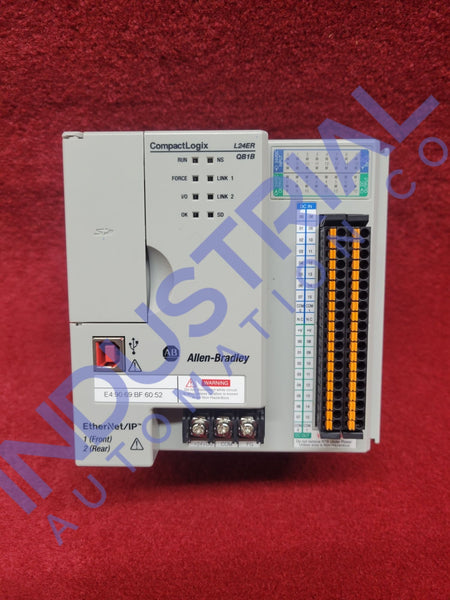Successfully Added
The product is added to your quote.

In industrial automation, choosing the suitable Programmable Logic Controller (PLC) can significantly affect your operations' efficiency, scalability, and overall success. Among the myriad choices available, two PLCs often stand out: Rockwell Automation's Allen-Bradley CompactLogix™ and MicroLogix™ series. As such, the question often arises: What is the difference between CompactLogix and MicroLogix?
At the heart of this query is understanding each system's unique capabilities, cost-effectiveness, programming environments, and the types of applications they are best suited for. Understanding the critical differences between CompactLogix vs. MicroLogix can guide decision-makers toward a solution that best meets their industrial automation needs.
This article delves deep into the distinct features, advantages, and practical applications of Allen-Bradley MicroLogix and CompactLogix control systems. We aim to give you insights to make informed decisions about the ideal PLC for your specific automation requirements.
So, let's explore CompactLogix vs. MicroLogix to uncover the unique attributes that each brings to the table in industrial automation.

CompactLogix represents a line of PLCs manufactured by Rockwell Automation under the Allen-Bradley brand. Part of the Logix platform, which includes the more extensive ControlLogix series, CompactLogix controllers are renowned for their versatility and scalability, fitting a wide range of industrial automation applications, particularly those of small or medium size.
These PLCs embody the idea of integrated architecture. They are designed to interact seamlessly with other devices in the system, creating a unified automation solution that significantly boosts efficiency and productivity. The underpinning design philosophy makes them a preferred choice for applications requiring sophisticated, high-performance controls without larger systems' physical bulk or cost.
Programmability is another key strength of the CompactLogix series. They are programmed using a highly modern environment, like Studio 5000 Logix Designer® software. This comprehensive engineering environment facilitates the configuration of your entire automation system, including PLCs, I/O, and network devices, enhancing your ability to create robust and flexible control systems.
Moreover, CompactLogix controllers stand out due to their support for Ethernet/IP high-speed communication. This capability allows these controllers to integrate data across an organization, driving connectivity from the plant floor to the enterprise level. Some models also offer integrated safety functionality for protecting personnel, equipment, and overall productivity.
Despite their advanced features and capabilities, these controllers are designed with compactness in mind. They deliver robust control capabilities within a smaller form factor, making them ideal for applications where space is limited but robust control is still required. In summary, CompactLogix controllers deliver the sophistication of larger control systems in a more compact, cost-effective package.
CompactLogix PLCs from Allen-Bradley offer numerous advantages, making them a favored choice for many industrial automation applications. These benefits derive from their integrated design, versatility, and high-end performance characteristics. Here are the key advantages:
These advantages make CompactLogix a highly effective solution for a wide variety of industrial automation applications, delivering robust control capabilities yet remaining compact and affordable.
MicroLogix PLCs, produced by Rockwell Automation under the Allen-Bradley brand, are a go-to solution for more straightforward, cost-sensitive applications requiring high I/O counts. Known for their compact size and relative ease of use, they offer a cost-effective control solution without compromising on the robustness characteristic of Allen-Bradley products.
Unlike more extensive and complex PLCs, MicroLogix controllers are designed with simplicity and economy. They provide a convenient solution for implementing control systems in scenarios where only essential control functions are needed. However, even within this framework of simplicity, they deliver a range of control capabilities.
These controllers typically use the RSLogix 500 programming environment. This simplicity makes them relatively easy to program and a popular choice among smaller-scale operations that may need more extensive programming resources.
MicroLogix controllers also offer flexibility in communication protocols. While some models support Ethernet/IP, others use RS-232 or RS-485 serial communication (or a combination), providing versatility based on the specific communication needs of your system.
Overall, MicroLogix controllers are designed for straightforward, cost-effective control applications. This simplicity makes them relatively easy to program and a popular choice among smaller-scale operations that may need more extensive programming resources.
The MicroLogix series, despite its simplicity, brings a set of distinct advantages to the table in the landscape of industrial automation. Here are the crucial strengths of these controllers that lend the series its unique appeal:
The MicroLogix series embodies the "small but mighty" ethos. Despite their simplicity and cost-effectiveness, these controllers can effectively meet various automation needs, making them valuable assets in different industrial scenarios.
While CompactLogix and MicroLogix are both PLC product lines from Allen-Bradley, they serve different automation needs and environments. Here's a breakdown of the key differences:

The decision between CompactLogix vs. MicroLogix hinges on your specific automation requirements, your available budget, and the complexity of your desired control system.
If your applications demand complex control, high-speed communication, and seamless integration with other devices and systems, CompactLogix might be the superior choice. However, MicroLogix could be your ideal fit for straightforward, cost-sensitive applications requiring robust but basic control capabilities.
Industrial Automation Co. has the experience and expertise to help you navigate these complex choices. Our automation professionals can guide you in selecting the PLC tailored to your operational needs—Trust Industrial Automation Co. is your reliable partner in finding the perfect automation solution.

CompactLogix and MicroLogix bring unique strengths, addressing various automation needs. Understanding these differences is vital to selecting the suitable PLC for your operations. No matter what you need, Industrial Automation Co. is here to help. Whether it's a CompactLogix 5370, a MicroLogix 1400, or any other PLC, let us be your partner in the world of automation. Contact us today to find the solution to drive your productivity to new heights.


